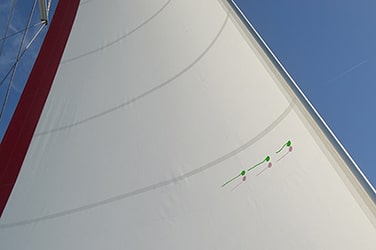
This article is an excerpt from NauticEd’s online FREE Basic Sail Trim Course, an interactive online sailing course for beginner to intermediate sailors to learn the basics of sail trim. Or if you want to learn more, upgrade to the Skipper Course Bundle to become a competent sailor!
You can learn to sail and improve your sailing with NauticEd, the international leader in sailing education.
Fairlead Control
The fairlead is the first control device that the jib sheet passes through on its way back to the cockpit. You can move the fairlead forward or backward.
When you move the fairlead all the way forward, the angle that the jibsheet pulls down and back on the jib sail changes so that it is pulling down more down on the leech (back trailing edge) of the sail and less along the foot (bottom) of the sail. Therefore, in the wind, you’d expect that the foot might pooch out more whereas the extra tension on the leech would keep it taut.
Conversely, when you move the fairlead all the way back towards the cockpit, you’re pulling more tension on the foot and less on the leech. In this case, in the wind, the foot would stay taut and not move much but the leech would “twist” out and away downwind. This is especially prevalent at the top of the jib where there is little tension holding it in place.
Obviously, then, there is a balance of where the fairlead should be set depending on sail set, boat heading, wind conditions, and reefing. Here is a really good and rough rule of thumb to use to set the fairlead position. First, imagine the geometric center of the triangular-shaped sail. This is defined by drawing imaginary lines from each corner to the center of each adjacent line. Where they all intersect, this is the geometric center. Now adjust the fairlead forward or back so that an imaginary line extending along the jibsheet would pass through the geometric center of the sail.

Figure 3.2-1 Components of the Jibsail
That’s a good rule of thumb and will keep you out of trouble. You can also predict from this rule that the fairlead should move forward if the jib sail is reefed. If the jib sheet is eased and the sail goes out and forward then the fairlead should also go forward. But this is a completely fine-tuning adjustment and most people, even racers, tend not to bother with this adjustment.
In the situation of high winds, we want to dump out or spill (not use) the wind at the top of the sail because it creates too much heeling force. Thus it’s easy to imagine that if we moved the fairlead backwards, it would reduce the tension on the leech and allow the leech at the top of the sail to twist out downwind and thus spill the wind at the top.
An example: You’re sailing along at about 60 degrees off the wind on starboard (wind coming over the starboard side of the boat first). You look at the telltales and the bottom ones are flying fine but the top red is flying wildly. What should you do?
Let’s work through the process; Red is on the port side of the sail and in this case, the outer side of the sail. So it needs more wind on it to smooth out its erratic behavior. If we move the fairlead backwards it lessens the tension on the leech and allows the top to twist out a little. When the sail twists out, more wind flows on the outer side of the sail and will thus straighten out the crazy red telltale.
If you’re not getting it – don’t worry. We’ve included an animation of a boat on a port tack here below to help understand. The challenge is to get all the telltales flying back. You’ll need to adjust the headsail and the fairlead control to make this happen. We’ve included two sail set scenarios: Close Reach and Reach. Click and drag on the sheet control and fairlead control to find the perfect combination to make all the telltales fly evenly backward. Then make adjustments to observe and predict the telltales based on the theory above.
Figure 3.2-2 Fairlead Control Animation for a boat on port tack.
Learn Basic Sail Trim for FREE...
A FREE 1-2 hour course that teaches how to work with sails to get your boat moving. The free Basic Sail Trim Course is for any aspiring sailor as well as experienced sailors wanting to learn more. Or, consider upgrading to the Skipper Course Bundle to become a fully competent skipper!
